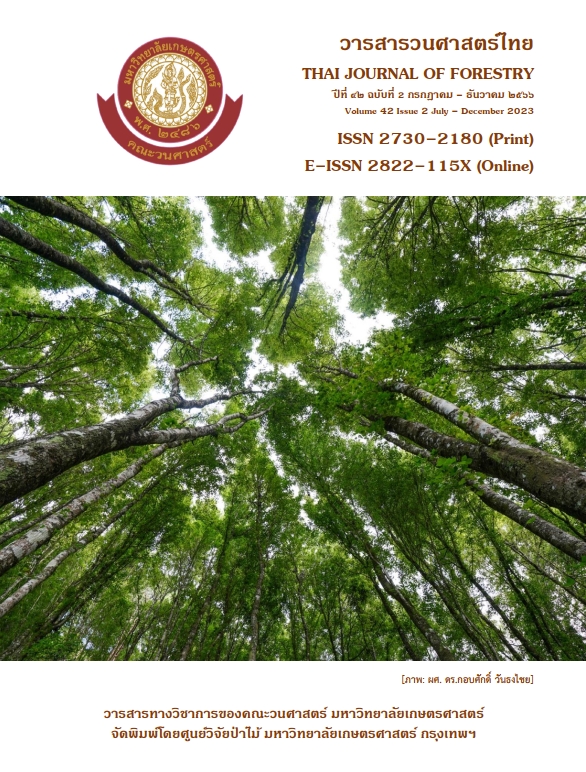การวิเคราะห์ลักษณะเฉพาะการตกของฝนโดยใช้วิธีการและจำนวนสถานีที่แตกต่างกัน บริเวณลุ่มน้ำแม่สาตอนบน อำเภอแม่ริม จังหวัดเชียงใหม่
Main Article Content
บทคัดย่อ
ข้อมูลลักษณะเฉพาะการตกของฝนมีความสำคัญต่อการวางแผนจัดการลุ่มน้ำและทรัพยากรน้ำ การใช้วิธีการและจำนวนสถานีในการวิเคราะห์เพื่อเป็นค่าน้ำฝนเชิงพื้นที่ที่ต่างกันอาจมีผลต่อค่าที่คำนวณได้ การศึกษานี้มีวัตถุประสงค์เพื่อเปรียบเทียบลักษณะเฉพาะการตกของฝน ได้แก่ จำนวนครั้ง จำนวนวัน ความยาวนาน ความหนักเบา และปริมาณ ที่คำนวณจากวิธีรูปหลายเหลี่ยมของทิสเสนที่ใช้ข้อมูลจำนวน 11 สถานี (TP) กับวิธีค่าเฉลี่ยเลขคณิต (AM) ที่ใช้ข้อมูลจำนวน 11, 5, 3 และ 1 สถานี โดยรวบรวมข้อมูลจากเครื่องวัดแบบบันทึกอัตโนมัติชนิดถ้วยกระดกระหว่างปี พ. ศ. 2548 – 2555 ผลการศึกษา พบว่า ความผันแปรของจำนวนครั้งที่ฝนตกรายวันที่คำนวณจากการใช้ข้อมูลเพียง 1 สถานี มีความแตกต่างกับการใช้วิธี TP ส่วนความผันแปรรายเดือน รายเดือนเฉลี่ย และรายปีไม่มีความแตกต่างกัน ความหนักเบาและความยาวนานของการตกของฝนมีความแตกต่างกันเมื่อใช้วิธีการและจำนวนสถานีที่แตกต่างกัน ความผันแปรของจำนวนวันที่ฝนตกรายเดือน และรายเดือนเฉลี่ยไม่แตกต่างกัน ส่วนรายปีมีความแตกต่างกับวิธี AM เฉพาะกรณีที่ใช้ข้อมูลจำนวน 3 และ 1 สถานีที่เป็นสถานีปลายน้ำ ความผันแปรของปริมาณน้ำฝนรายวันที่คำนวณจากการใช้ข้อมูลเพียง 1 สถานี มีความแตกต่างกับการใช้วิธี TP ส่วนปริมาณน้ำฝนรายเดือน รายเดือนเฉลี่ยและรายปีไม่มีความแตกต่าง จำนวนสถานีที่เหมาะสมคืออย่างน้อย 3 สถานีที่ตั้งกระจายครอบคลุมทั้งพื้นที่และระดับความสูงของพื้นที่ลุ่มน้ำตั้งแต่ตอนบน กลาง และปลายน้ำ
Downloads
Article Details

อนุญาตภายใต้เงื่อนไข Creative Commons Attribution-NonCommercial-NoDerivatives 4.0 International License.
ข้าพเจ้าและผู้เขียนร่วม (ถ้ามี) ขอรับรองว่า ต้นฉบับที่เสนอมานี้ยังไม่เคยได้รับการตีพิมพ์และไม่ได้อยู่ในระหว่างกระบวนการพิจารณาตีพิมพ์ลงในวารสารหรือสิ่งตีพิมพ์อื่นใด ข้าพเจ้าและผู้เขียนร่วม (ถ้ามี) ยอมรับหลักเกณฑ์และเงื่อนไขการพิจารณาต้นฉบับ ทั้งยินยอมให้กองบรรณาธิการมีสิทธิ์พิจารณาและตรวจแก้ต้นฉบับได้ตามที่เห็นสมควร พร้อมนี้ขอมอบลิขสิทธิ์ผลงานที่ได้รับการตีพิมพ์ให้แก่วารสารวนศาสตร์ คณะวนศาสตร์ มหาวิทยาลัยเกษตรศาสตร์ กรณีมีการฟ้องร้องเรื่องการละเมิดลิขสิทธิ์เกี่ยวกับภาพ กราฟ ข้อความส่วนใดส่วนหนึ่ง หรือ ข้อคิดเห็นที่ปรากฏในผลงาน ให้เป็นความรับผิดชอบของข้าพเจ้าและผู้เขียนร่วม (ถ้ามี) แต่เพียงฝ่ายเดียว และหากข้าพเจ้าและผู้เขียนร่วม (ถ้ามี) ประสงค์ถอนบทความในระหว่างกระบวนการพิจารณาของทางวารสาร ข้าพเจ้าและผู้เขียนร่วม (ถ้ามี) ยินดีรับผิดชอบค่าใช้จ่ายทั้งหมดที่เกิดขึ้นในกระบวนการพิจารณาบทความนั้น”
เอกสารอ้างอิง
Amatayakul, P., Chomtha, T. 2013. Agricultural Meteorology to Know for Chiang Mai. Meteorological Department, Bangkok, Thailand. (in Thai)
Asawa, G.L. 2005. Irrigation and Water Resources Engineering. New Delhi: New Age International Publishers. New Delhi, India.
Bosch, D.D., Sheridan, J.M., Davis., F.M. 1999. Rainfall characteristics and spatial correlation for the Georgia Coastal Plain. Transactions of the ASAE. American Society of Agricultural Engineers, 42(6): 1637-1644.
Boonterm, K. 2002. GIS Application in Determining Mountainous Rainfall Characteristics at Mae Chaem Watershed, Changwat Chiang Mai. M.S. Thesis, Kasetsart University. Bangkok, Thailand. (in Thai)
Chow, V.T., Maidment, D.R., Mays, L.W. 1988. Applied Hydrology. New York: McGraw-Hill Book Company. New York, USA.
Dezfuli, A.K., Icoku, C.M., Mohr, K.I., Huffman, G.J. 2017. Precipitation characteristics in west and east Africa from satellite and in situ observations. Journal of Hydrometeorology, 18(6): 1799-1805. doi.org/10.1175/JHM-D-17-0068.1.
Didier, N., Ogwang, B.A., Ongoma, V. 2016. The Impacts of topography on spatial and temporal rainfall distribution over Rwanda Based on WRF Model. Journal of Atmospheric and Climate Sciences, 6(2): 145-157. doi: 10.4236/acs.2016.62013.
Glomvinya, S., Tantasirin, C., Tongdeenok, P., Tanaka, N. 2016. Change in rainfall characteristics at Huai Kog-Ma watershed, Chiang Mai province. Thai Journal of Forestry, 35(2): 66-77. (in Thai)
Glomvinya, S. 2016. Rainfall Characteristics at Huai Kong-Ma Watershed, Chiang Mai Province. M.S. Thesis, Kasetsart University. Bangkok, Thailand. (in Thai)
Intama, A. 2009. Preliminary Test Run of KINEROS 2 Model for Estimating Sediment Yield at Mae Sa Subwatershed, Chiang Mai Province. M.S. Thesis, Kasetsart University. Bangkok, Thailand. (in Thai)
Karl, P. 1900. On the criterion that a given system of deviations from the probable in the case of a correlated system of variables is such that it can be reasonably supposed to have arisen from random sampling. Philosophical Magazine. Series 5, 50(302): 157–175.
Kendall, M. G. 1975. Rank Correlation Methods, 4thed. Charles Griffin, London, U.K.
Land Development Department. 2000. Mae Sa Watershed Land Use Plan. Bangkok, Thailand. (in Thai)
Laksana, P.J. 2015. Rainfall characteristic on the slopes of mount Merapi region. Journal of the Civil Engineering Forum, 1(3): 43-50.
Lee, J., Kim, S., Jun, H. 2018. A study of the influence of the spatial distribution of rain gauge networks on areal average rainfall calculation. Water, 10(11): 1635. doi:10.3390/w10111635
Mann, H.B., Whitney, D.R. 1947. On a test of whether one of two random variables is stochastically larger than the other. The Annals of Mathematical Statistics, 18(1): 50–60. doi:10.1214/aoms/1177730491.
Nash, J.E., Sutcliffe J.V. 1970. River flow forecasting through conceptual model part I – A discussion of principles. Journal of Hydrology, 10(3): 282–290.
Nazaripour, H., Daneshvar, M.R.M. 2017. Rain gauge network evaluation and optimal design using spatial correlation approach in arid and semi-arid regions of Iran. Theoretical and Applied Climatology, 129(3-4): 1255-1261. doi:10.1007/s00704-016-1853-3
Perreault, S., Alem, A.E., Chokmani, K., Cambouris, A.N. 2022. Development of Pedotransfer functions to predict soil physical properties in Southern Quebec (Canada). Agronomy, 12(2): 526. doi:10.3390/agronomy12020526.
Thepnumsommanus, S. 2004. Effect of Topography and Rainfall Characteristics on Rainfall Erosivity Index of Mountainous Area at Mae Chaem Watershed, Chiang Mai Province. M.S. Thesis, Kasetsart University. Bangkok, Thailand. (in Thai)
Uchechukwu, N.B., Njideka, O. 2022. Nigerian rain gauge station optimization and national development: the importance of head count. Materials Science and Engineering, 413(1): 012022. doi:10.1088/1757-899X/413/1/012022.
World Meteorological Organization (WMO). 1976. Guide to Hydrological Practices, Volume-I: “Hydrology - From Measurement to Hydrological Information”, WMO No. 168. Geneva, Switzerland.
Wood, S.H., Ziegler, A.D., 2008. Floodplain sediment from recent 50-year-recurrence floods of the Ping River in Northern Thailand. Hydrology and Earth System Sciences, 12, 959-973
Ziegler, A.D., Xi, L.X., Tantasirin, C. 2011. Sediment monitoring in the Mae Sa catchment in Northern Thailand. International Association of Hydrological Sciences, 349: 86-91.


